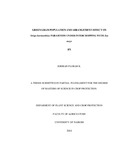| dc.description.abstract | In Kenya maize is the staple food crop with 80% of the population using it as the main human food. Maize shortage in Kenya always causes food crisis threatening political and economic stability. Weeds are a major constraint to maize production due to associated losses and increased costs of their management. Striga is a major maize production hindrance with estimated losses ranging between 40-100 % in Africa. In Kenya Striga is mainly found in the Western part of the country. A trial was conducted at Kari Alupe in Busia County during the short rainy season in 2012 and the long rainy season in 2013.The aim of this study was to establish if intercropping maize with green grams has any effect on Striga reduction, and if so which is the best intercropping arrangement for the green grams. A maize variety susceptible to Striga Hybrid 403 and a green gram variety KS 20 were used. The treatments included, green grams planted in same hill with the maize, one row of green grams planted between two rows of maize, two rows of green grams planted between two rows of maize, broadcasting between two maize rows and thinned to the recommended population of 222,083 plants/ha and green grams planted in the same hill plus one line of green grams between two maize rows, maize alone with Striga incorporated, maize without Striga and green grams sole crop. The experiment was laid out in a randomized complete block design and replicated four times. Data collected included the number of Striga counts from eight weeks to fourteen weeks after planting at an interval of two weeks, wet grain weight of the naked cobs, dry grain yield, 1000 seed weight, the plant and ear height, number of cobs per plot, cob diameter per plant, cob length per plant and cob height per plant. Green grams parameters included; the number of branches per plant, number of pods per plant, plant population per plot and the grain weight of green gram per plot . Data collected was
xiv
analyzed using GenStat software package version fourteen and ANOVA was used to assess the effects of different treatments. The treatment means were separated using Duncan’s multiple range test at P<0.05 to recommend the most efficient and cost effective intercropping arrangement of green grams in Striga control. Results on Striga weed counts indicate that intercropping maize with green grams had significantly lower Striga counts when compared with maize that was artificially infested with Striga. Green grams plant arrangement had no significant differences in the Striga counts. Intercropping maize with green grams in the short rains had significantly higher dry grain weight when compared to the maize that was artificially infested with Striga. In the long rains intercropping had no significant difference between the dry grain weights when compared to the maize that was naturally infested with Striga. In the short rains uncontrolled Striga reduced dry grain weight by 67% while in the long rains it reduced the dry grain weight by83% when uninfested maize was compared to infested one. Intercropping reduced Striga incidence and increased the dry grain weight and since it is affordable to small scale farmers they should be encouraged to grow maize intercropped with green grams to manage Striga weeds, improve maize yield and achieve better utilization of land and labour. | en_US |

